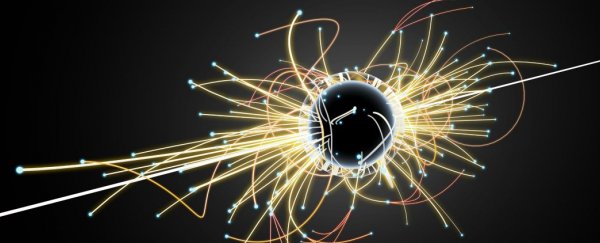After 85 years of searching, researchers have confirmed the existence of a massless particle called the Weyl fermion for the first time ever. With the unique ability to behave as both matter and anti-matter inside a crystal, this strange particle can create electrons that have no mass.
The discovery is huge, not just because we finally have proof that these elusive particles exist, but because it paves the way for far more efficient electronics, and new types of quantum computing. "Weyl fermions could be used to solve the traffic jams that you get with electrons in electronics - they can move in a much more efficient, ordered way than electrons," lead researcher and physicist M. Zahid Hasan from Princeton University in the US told Anthony Cuthbertson over at IBTimes. "They could lead to a new type of electronics we call 'Weyltronics'."
So what exactly is a Weyl fermion? Although we're often taught in high school science that the Universe is made up of atoms, from a particle physics point of view, everything is actually made up of fermions and bosons. Put very simply, fermions are the building blocks that make up all matter, such as electrons, and bosons are the things that carry force, such as photons.
Electrons are the backbone of today's electronics, and while they carry charge pretty well, they also have the tendency to bounce into each other and scatter, losing energy and producing heat. But back in 1929, a German physicist called Hermann Weyl theorised that a massless fermion must exist, that could carry charge far more efficiently than regular electrons.
And now the team at Princeton has shown that they do indeed exist. In fact, they've shown that in a test medium, Weyl electrons can carry charge at least 1,000 times faster than electrons in ordinary semiconductors, and twice as fast as inside wonder-material graphene.
They're also far more efficient than electrons, the team reports in Science, because the particle's spin is both in the same direction as its motion (which physicists call 'right-handed) and opposite its direction ('left-handed') at the same time. This means that all the fermions move in exactly the same way and can traverse through and around obstacles that scatter normal electrons.
"It's like they have their own GPS and steer themselves without scattering," Hasan said in a press release. "They will move and move only in one direction since they are either right-handed or left-handed and never come to an end because they just tunnel through. These are very fast electrons that behave like unidirectional light beams and can be used for new types of quantum computing."
What's particularly cool about the discovery is that the researchers found the Weyl fermion in a synthetic crystal in the lab, unlike most other particle discoveries, such as the famous Higgs boson, which are only observed in the aftermath of particle collisions. This means that the research is easily reproducible, and scientists will be able to immediately begin figuring out how to use the Weyl fermion in electronics.
The team found the particle after specially formulating a semi-metal crystal called tantalum arsenide, which had previously been flagged by researchers in China as a potential 'home' for the Weyl fermion. After finding traces of the elusive particle in their lab, they took the crystals to the Lawrence Berkeley National Laboratory in California, where they fired high-energy photon beams through them. The signature of the beams on the other side confirmed that the crystals did indeed contain the Weyl fermion.
Weyl fermions are what's known as quasiparticles, which means they can only exist in a solid such as a crystal, and not as standalone particles. But further research will help scientists work out just how useful they could be. "The physics of the Weyl fermion are so strange, there could be many things that arise from this particle that we're just not capable of imagining now," said Hasan.
We can't wait to find out.
